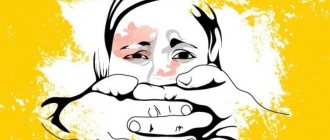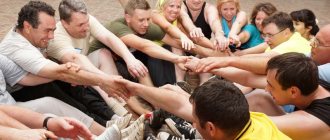We all belong to different social groups and talk about them often. In this article you will learn what social groups are, what characteristics, types and functions they have, as well as why people join groups in general, what causes the emergence of social groups.
To learn how to interact within a social group, find approaches to people, learn how to negotiate and interact better with people, sign up for the online program “Best Communication Techniques”. You will learn and be able to apply in your life 72 of the best communication techniques that we have collected from dozens of books and trainings.
Social group definitions
There is no single clear definition of a social group, so we decided to give several at once:
A social group is an association of people who have a common significant social characteristic on which their participation in some activity is based, connected by a system of relations that are regulated by formal or informal social institutions.
A social group is an objectively existing stable community, a collection of individuals interacting in a certain way based on several characteristics, in particular the shared expectations of each group member regarding others.
A social group is a socially organized community of people united by common interests, goals and joint activities.
Taken together, these definitions make it possible to form the most accurate picture of what a social group is. But there are other features that you should be aware of.
Concept and tasks
In modern psychology, the concept of “social group” is a collection of individuals who have similar features, perform the same type of activity, and perceive themselves as members of a community. The group has 3 main qualities:
- mandatory interaction between participants;
- unity of goals for which the group was created;
- all members have a characteristic unique to this community.
Social psychology of groups studies the process of group formation, its types, structure and influence on the individual. The task of the industry is to assess and forecast the development of the group, identify the characteristics of interaction, and the main criteria. Throughout life, a person simultaneously belongs to several groups and often moves from one to another. This is due to a change in activity or status: for example, a schoolchild becomes a student, a worker becomes a pensioner. In this regard, we can highlight the main task of social psychology of groups - classification according to certain criteria.
Signs, types and functions of social groups
First, let’s look at the signs by which a social group can be identified:
| ✔ | Interaction of its members. It can be either direct or indirect. |
| ✔ | The presence of relationships between group members. |
| ✔ | Sustainability. In other words, a social group cannot be called a community of people that exists for a small amount of time. |
| ✔ | Having a common goal. |
| ✔ | Role expectations of group members regarding each other. |
| ✔ | Role expectations of group members regarding each other. |
| ✔ | Availability of internal organization and structure. It is not necessary for each member's role to be formally assigned. For example, if you carefully analyze your communication with your friends, you will notice that each of you has been assigned a role. |
| ✔ | Feeling of belonging to a group. |
| ✔ | The presence of specific group behavior patterns. |
Social groups can be classified in several ways:
| ✔ | Big and small. The former include ethnic groups, social classes, professional groups, etc., the latter – the family, work collective, etc. |
| ✔ | Formal and informal. |
| ✔ | Primary and secondary. In the primary group, its members communicate with each other directly and with high emotionality, while communication in the secondary group is formal, official and impersonal. An example of a primary group is a company of friends, a secondary group is a business company. |
It is also worth considering the concepts of ingroup and outgroup. An ingroup is “one’s own,” the group to which an individual belongs. Outgroup – “strangers”, a group to which an individual does not belong.
And, of course, social groups perform certain functions. Firstly, this is the socialization of the individual. A person cannot live outside of any social groups. Secondly, in difficult situations people come together and the group helps them cope with their problems.
Thirdly, an instrumental function is performed: people unite in a group to achieve certain goals. Finally, the group helps people meet their needs for approval and support. But it’s worth saying a little more about this.
Conditional groups - are identified and united on the basis of certain characteristics - gender, age, nationality, etc. People included in a conditional group may never meet each other, but have common social and psychological characteristics.
Real groups are truly existing associations of people. They are characterized by the fact that its members are interconnected by objective relationships.
Large groups are quantitatively unlimited communities of people, identified on the basis of various social characteristics (demographic, class, national, party).
Large groups can be real (contact), forming a social community that includes a significant number of people existing in a common space and time. Large groups of this kind may include the workforce of an enterprise, school or medical institution, where many health workers may not be in direct contact with each other, but at the same time report to the same managers (chief physician, deputies), adhere to common principles for all internal regulations, etc.
In large groups, cultural values are formed, traditions are developed, basic values - ideology. Social communication in large social groups is carried out by means of mass communication.
Large groups can be conditional, distinguished and united on the basis of certain characteristics - gender, age, nationality, property, etc. People who find themselves included in a large conditional group may never meet each other, but have common social and psychological characteristics based on the basis by which they were united.
Varieties of large spontaneous groups - crowd, mass, public.
A crowd forms on the street in connection with an event; the duration of its existence is determined by the significance of the incident. If the event is minor (for example, a traffic accident without serious consequences), the crowd quickly disperses; if the incident is major and causes strong excitement (for example, a message about a possible terrorist attack), then excitement increases, and the crowd can move on to active, unpredictable actions. The state of the crowd is unstable, behavior is spontaneous and can lead to aggressive forms.
Mass is a more stable formation with fuzzy boundaries. The mass may not necessarily act as a momentary formation, like a crowd; it can turn out to be much more organized when certain sections of the population quite consciously gather for the sake of some kind of action: manifestation, demonstration, rally. In this case, the role of the organizers is higher: they are usually not nominated directly at the moment of the start of action, but are known in advance as the leaders of those organized groups whose representatives took part in this mass action.
An audience is also a short-term gathering of people to spend time together in connection with some kind of spectacle - on the stands of a stadium, in a large auditorium, on a square in front of a speaker while listening to an important message. The public always gathers for a common and specific purpose, so it is more manageable, in particular, it more closely follows the norms adopted in the chosen type of organization of spectacles. But the public remains a mass gathering of people, and the laws of mass apply within it. Here, too, an incident is enough for the public to become uncontrollable.
A small group is understood as a small group whose members are united by common social activities and are in direct personal communication, which is the basis for the emergence of emotional relationships, group norms and group processes.
Emerging groups are groups already defined by external requirements, but not yet united by joint activity in the full sense of the word.
Highly developed groups are groups characterized by an established structure of interaction, established business and personal relationships, the presence of recognized leaders, and effective joint activities.
According to the level of development, the following groups are distinguished:
- diffuse - groups at the initial stage of their development, a community in which people are only co-present, i.e. they are not united by joint activities;
- association - a group in which relationships are mediated only by personally significant goals (group of friends, buddies);
— cooperation is a group characterized by a really functioning organizational structure, interpersonal relationships are of a business nature, subordinated to achieving the required result in performing a specific task in a certain type of activity;
— a corporation is a group united only by internal goals that do not go beyond its framework, striving to achieve its group goals at any cost, including at the expense of other groups. Sometimes corporate spirit can acquire features of group egoism;
— a team is a highly developed, time-stable group of interacting people, united by the goals of joint socially beneficial activities, characterized by a high level of mutual understanding of each other, as well as the complex dynamics of formal and informal relationships between group members.
The composition of the teams is:
Homogeneous - better at solving simple problems.
Heterogeneous - more effective in solving complex problems, as well as in intense creative work (brainstorming).
These differences may relate to gender, age, profession, status, level of education.
A formal group is a group whose emergence is due to the need to implement certain goals and objectives facing the organization in which the group is included. A formal group is distinguished by the fact that all the positions of its members are clearly defined in it; they are prescribed by group norms. It also strictly distributes the roles of all group members in the system of subordination to the so-called power structure: the idea of vertical relationships as relationships defined by a system of roles and statuses. An example of a formal group is any group created in the context of a specific activity: a work team, a school class, a sports team, etc.
Informal groups develop and arise spontaneously both within formal groups and outside them, as a result of mutual psychological preferences. They do not have an externally defined system and hierarchy of statuses, imposed roles, or a given system of vertical relationships. However, an informal group has its own group standards of acceptable and unacceptable behavior, as well as informal leaders. An informal group can be created within a formal one, when, for example, in a school class, groups arise consisting of close friends united by some common interest. Thus, two relational structures are intertwined within the formal group.
But an informal group can also arise on its own, outside of organized groups: people who accidentally come together to play football or volleyball somewhere on the beach or in the yard of a house. Sometimes within such a group (say, in a group of tourists going on a one-day hike), despite its informal nature, joint activity arises, and then the group acquires some of the features of a formal group: it has certain, albeit short-term, positions and roles.
In reality, it is very difficult to distinguish strictly formal and strictly informal groups, especially in cases where informal groups arise within the framework of formal ones. Therefore, in social psychology there are two concepts “group” and “organization”.
According to the degree of psychological acceptance on the part of the individual, groups are divided into “reference groups” and “membership groups.”
A membership group is a group of which a given individual is an actual member.
A reference group is understood as a group of people who are in some way significant for an individual, to which he voluntarily associates himself or of which he would like to become a member, acting for him as a group standard of individual values, judgments, actions, norms and rules of behavior.
The reference group may be real or imagined, positive or negative, and may or may not coincide with the membership group.
“Positive” are those with which the individual identifies himself and of which he would like to become a member.
“Negative” reference groups include those that cause rejection in the individual.
Why do people join social groups?
Firstly, a social group satisfies a person’s need for love, support, approval, communication, attention, and a sense of belonging. A person has needs that he can satisfy only in some social group.
Secondly, the group involves cooperation. There are a huge number of goals that we want to achieve, but we cannot do it alone. But with joint efforts this is quite achievable. We unite to accomplish any tasks.
Thirdly, we feel safe in a social group. The group can protect against enemies if there are any. But even if there are no enemies, a person still needs to feel protected.
Fourthly, in social groups there is an exchange of knowledge and information, mutual learning. We get the opportunity to find out and learn what was previously inaccessible to us.
Fifthly, belonging to a group forms a social identity, which becomes part of our “I-concept”.
And in conclusion, we invite you to reflect and answer 2 questions. What social groups do you belong to? Name 3-7 main ones. And what does belonging to these social groups give you? How do you benefit from being a member? This will help you understand yourself better and be more critical of your environment.
We wish you success!
We also recommend reading:
- Storytelling
- “Group puzzle” technique in pedagogy
- Ringelmann effect
- The influence of social roles on personality development
- What is conformity and how to avoid it
- Interactionism in social psychology
- Charette procedure
- Social stereotypes
- Socialization of personality: briefly about the main thing
- Stages of team formation according to Tuckman
- Causes of prejudice
Key words:1Communication
History of development
Social psychology began studying groups only at the beginning of the 20th century. Previously, the object of study was the individual, not society. They examined in depth the characteristics of perception, attitudes, and interpersonal interaction, but did not try to evaluate a person as an integral part of formation.
Some psychologists completely denied the existence of groups as objects of study. This approach in social psychology was called personalistic. But in parallel with it, another way of studying developed - sociological. Its proponents argued that one cannot fully understand the motives of a person's behavior if one studies him only as an individual. A group, as an association of people, inevitably influences a person and this cannot be ignored.
The study of group processes has developed more actively in the United States. Under the leadership of K. Levin, research was carried out in the laboratory studying the dynamics, types of leadership, cohesion and other categories that determine the behavior of formations.
Already in the middle of the 20th century, personalistic and sociological psychology joined forces. This happened under the influence of government agencies interested in the emergence of new effective methods of managing industrial and military organizations. Interest in the study of various formations only increased by the end of the 20th century. Nowadays, research methods continue to expand and improve.
Youth as a large group
Youth is a socio-demographic group defined by a set of age characteristics (approximately from 16 to 25 years1), characteristics of social status and certain social and psychological attributes.
Youth is a period of choosing a profession and one’s place in life, forming a worldview and life values, choosing a life partner, starting a family, achieving economic independence and socially responsible behavior.
Adolescence is a specific stage, a period in the human life cycle, which is biologically universal.
Features of the social status of adolescents
- Transitional position.
- High degree of mobility.
- coping with new social roles (worker, student, citizen, family man) associated with changes in status.
- They are actively looking for their place in life.
- Favorable job prospects and career growth.
Young people are the most active, mobile and dynamic part of the population, free from the stereotypes and prejudices of previous years and having the following socio-psychological characteristics: unstable psyche; internal inconsistency; low level of tolerance (from Latin tolerantia - patience); the desire to stand out, to be different from others; the presence of a specific youth subculture.
It is typical for young people to form informal groups, which are characterized by the following features:
- Emergence on the basis of spontaneous communication in certain conditions of a social situation;
- self-organization and independence from official structures;
- obligatory for participants and differing from typical patterns of behavior accepted in society, aimed at realizing life needs that are unsatisfied in conventional forms (they are aimed at self-affirmation, giving social status, gaining security and prestige of self-esteem)
- relative stability, a certain hierarchy among group members;
- expression of different value orientations or even worldviews, stereotypical behavior atypical for society as a whole
- attributes that emphasize belonging to a particular community.
Depending on the characteristics of youth amateurism, youth groups and movements can be classified as.
Aggressive amateurism
It is based on the most primitive ideas about the hierarchy of values, based on the cult of persons. Primitivism, the appearance of self-affirmation. Popular among young people and teenagers with minimal intellectual and cultural development.
Shocking (French epater - to impress, to amaze) Amateurism.
It is based on challenging norms, canons, rules, opinions both in everyday, material life - clothes, hairstyles, and in spiritual life - art, science. “Challenging” aggression towards oneself from other people in order to be “noticed” (punk style, etc.).
Alternative amateur activity.
Based on the development of alternative, systematically contradictory models of behavior that become an end in themselves (hippies, Hare Krishnas, etc.).
Social amateurism
is focused on solving specific social problems (environmental movements, movements for the revival and preservation of cultural and historical heritage, etc.).
Small group structure based on sociometry
When we talk about structure, we mainly mean a small group, where the relationships of people and their statuses are visible, and the leaders and the outcasts are noticeable, one might say, with the naked eye. In social psychology there is a special technique for studying the structure of a small group, which is called “sociometry”.
Sociometric studies are based on the principle of choice: each group member must choose the three most preferred (attractive, reliable, etc.) classmates and three rejected ones. After analyzing the data obtained, the following elements of the group structure can be identified:
- sociometric “stars” - people who received the largest number of elections; they are not necessarily leaders and often do not strive to be, but the "stars" are definitely the most respected in the group;
- preferred - those who received quite a lot of selections, but fewer “stars”;
- “average” – the number of choices is small, but they exist;
- neglected - those who did not receive positive elections;
- outcasts – people who have collected a large number of negative choices;
- microgroups – 3-4 people, connected by mutual elections.
Such research gives a complete picture of the structure of a small group and is very useful for the work of a leader with a team or a teacher with a class.
The system of groups that make up society resembles both an intricate puzzle of relationships and interdependencies, and a clear, ordered structure and hierarchy in which some groups (small) are part of larger ones and themselves include microgroups.
Connections between social groups are not only a consequence of intergroup interaction. They are carried out through individuals who are simultaneously members of different groups. Problems, conflicts, dynamic processes in one group are reflected in many others. For example, a person who is preoccupied with problems with his superiors often takes out his bad mood on his family, friends, members of a sports club, etc. And on the contrary, a good, strong family, positive relationships with friends are the key to a favorable psychological climate in a professional team.
Classification
The characteristics that differentiate groups and how people perceive groups in everyday life constitute intuitive theories about them.
Intuitive typologies converge across four types of groups: proximity, task, social categories, and weak associations. Each group is assigned different characteristics based on certain criteria. People have intuitive theories of groups, and the more general concept of a group can be divided into a typology of groups that differ in their properties, type of interaction, and functions:
- Affinity groups: Long-term, small and with porous boundaries, they have a high degree of interaction and common goals and results, as well as importance and similarity between their members.
- Workgroups: medium-duration, small, with boundaries of moderate permeability, moderate-strong interaction, have common goals with common results, imparting medium-high importance and medium similarity.
- Category groups: long-term, large, low-permeability boundaries, weak interaction, have common goals with common results, resulting in medium importance and medium-low similarity.
The concept of a group in psychology
To make the definition of a group more understandable, let’s combine them according to the following characteristics:
- Media interdependence.
- Identity or consideration of perceptual-cognitive aspects.
- Interaction between participants and the social structure of the group.
According to Marvin Shaw, every group should have the following characteristics:
Let's look at the different definitions of groups:
- Definitions based on interdependence of members:
It should be noted that interdependence is a common characteristic of most definitions of the concept of group. This approach defends that the essential aspect for a group of people to be called a group is that there is interdependence among them. According to Levine, the group's definition would be:
“The concept of a group as a dynamic whole must include a definition of the group based on the interdependence of the members (or rather subdivisions of the group)” (Lewin, 1936)
Another defender of this movement was Deutsch, who gave the following definition of the group:
“A sociological group exists to the extent that its components pursue goals that promote interdependence.”
- Definitions based on identity or perceptual-cognitive aspects:
Another definition is postulated from the theory that groups are formed for the purpose of giving an individual a social identity. That is, the group is formed as a group. And in this sense of belonging and identity, members must be aware of it.
- Definitions based on the interaction of members and the social structure of the group:
The third important criterion is the interaction between group members. This one protects the same interaction that supports the group definition. In this sense, the opinions of different authors differ, because while some advocate that interaction is an important element of group formation, others believe that it is not a necessary requirement for group formation.
Group sizes
Let's consider this issue through the prism of the “Dunbar number” . This is a number that has been repeated throughout history and between different cultures, such as nomadic peoples, major units of the Roman army, and also today the number of workers in a company at the same hierarchical level.
This was discovered by correlating the cortical size of 36 primate species with the number of components of their groups, creating a regression equation that could predict that both variables corresponded to each other.
Correlating this information with information about a human being, the conclusion is that 147.8 is the average number of social relationships that we establish
.
Thus M. Shaw compiled a kind of average census of these groups, concluding that they were divided into three categories:
- small (from 30 to 50 individuals);
- medium (from 100 to 200);
- large (from 500 to 2500).
In his in-depth study of groups throughout history and in the early stages, he discovered that:
- 150 inhabitants was the average number of inhabitants of a Neolithic village.
- The number of teachers in the subspecialization of the discipline ranged from 150 to 200.
- 150 is the number of soldiers found in a unit on average from Ancient Rome to the 16th century.
More importantly, if the force was to be larger, it had to be divided into "manageable" groups, which always numbered around 150 people.
Hence, anthropologists around the world began to study the “Dunbar number” as a “hot topic.” "Dunbar's Number" began to be used in marketing theories and applications and even to study groups of people in virtual worlds.
Mandatory stages of development and roles of individuals within formations
A group is not formed immediately after people unite. Stages of socio-psychological maturity:
- Conglomerate - strangers find themselves in the same territory for the first time.
- A nominal group - a community receives a name and status.
- Association - a structure is formed, common interests appear.
- Cooperation is active joint interaction, clear designation of roles and structure, formation of intra-group morality.
- Autonomy - in the process of joint activity, the desires of individuals are satisfied.
- A corporation is a closed community that is opposed to others.
- Team - joint activity presupposes integrativeness (collective decision-making).
Each person has his own role in formation, which he performs consciously or simply obeys the imposed model of behavior. There are 3 types of roles:
- Social roles. Necessary to maintain dynamics. Increase cohesion and emotional connections between people. These include: mediator, peacemaker, observer.
- Roles aimed at performing common tasks. They help achieve the goal set before the formation. They assume rational use of resources and minimize efforts. These include: initiator, informant, coordinator, mentor.
- Roles aimed at achieving personal interests. They disorganize participants by using community resources to achieve their own benefit. These include: loner, skeptic, aggressor, cynic.
The manager’s task is to monitor the fulfillment of roles, encourage relationships that are beneficial for the community, and promptly stop the activities of disruptors.










